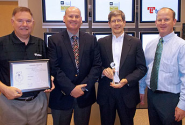-
About
- About Listly
- Community & Support
- Howto
- Chrome Extension
- Bookmarklet
- WordPress Plugin
- Listly Premium
- Privacy
- Terms
- DMCA Copyright
- © 2010-2024 Boomy Labs


Over the last decade, enterprise LANs have evolved as a result of changes in the workplace. This in turn led to changes in LAN traffic management and LAN architecture. In a blog post 2 weeks ago, I addressed 2 key considerations to achieve superior traffic management - common LAN traffic restrictions and quality of service.

Operators are often short on resources - especially for large complex network projects. So outsourcing program management, planning and delivery can be the key to success. Supporting the move to an LTE-Ready IP Network Tellabs recently partnered with a leading U.K. operator to drive its complex, multi-vendor 4G network migration project.

By Roger Heinz, Executive Vice President, Global Sales and Services - August 1, 2013 / 10:00 AM Enterprise demand for bandwidth-hungry services is rapidly growing. High-speed enterprise applications -- such as video streaming, cloud services and data center connections -- tax existing networks.

Tellabs already partners with many major operators in Western Europe. Increasingly, we?re working to address the network challenges of new customers in the growing economies of Russia, Eastern Europe, the Middle East and Africa. Today I want to highlight some of our local team members who support our business across this diverse region.

The days of designing LANs (local area networks) to support telephones, desktop workstations and locally switched traffic are over. Ten years ago, LANs were designed to support peer-to-peer traffic flows because 80%of traffic stayed local. Today, about 90% of LAN traffic flows directly to the WAN (wide area network).

One challenge facing telecom service providers is exponential growth in data traffic from consumers and enterprises. Streaming video consumption, adoption of cloud services and proliferation of high-bandwidth Ethernet services are driving traffic growth. Such growth has driven development of 100G transport solutions. The industry has largely standardized on coherent based PM-QPSK technology for 100G transmissions.

Our customers entrust huge amounts of customer traffic and corporate reputation to Tellabs when they decide to deploy our systems. So it's critical that Tellabs has the highest capability to solve problems and make decisions quickly and accurately whenever an operating problem is encountered.

Vtesse Networks' CTO: Taking the Easy Road to Ultra-Fast 100G By Tarcisio Ribeiro, Vice President, Europe, Middle East and Africa Sales - July 16, 2013 / 10:00 AM To stay ahead of customer demands, long-time Tellabs customer Vtesse Networks recently rolled out its ultra-fast 100GbE optical network service.

Short-term fixes to long-term problems are disastrous for any company. This is especially true for those working to address the growing network congestion issue. High-demand services, such as high-speed data, video and cloud-based services, are creating bottlenecks unlike anything the industry has seen before. A key contributor to the issue is the cloud-service model.

By Roger Heinz, Executive Vice President, Global Sales and Services - July 9, 2013 / 10:00 AM The long-running debate about whether to use fiber optics or copper in the network is over. Fiber won years ago among telecom service providers in long-haul, metro and residential networks.

The long-term vision of Tellabs 7100 OTS is based the concept that as the network traffic begins to grow, network operators would benefit from an integrated, multi-service transport network to achieve the lowest cost-per-bit.

At Tellabs, we pride ourselves in staying true to our company values - be our customers' trusted partner, relentlessly innovate for success, be accountable, act with respect and integrity and grow profits and shareholder value. We would like to pay tribute to three of our team members that continually go above and beyond in making these values a reality.

Optical LAN, also known as GPON, is a game changer. Just look at the numbers. By replacing copper Ethernet LAN with fiber optics, you can save up to 70% of ownership cost, 80% of power requirements and 90% of space requirements. The reasons to make the shift to Optical LAN are clear.

Mobile operators need to balance the quality of users' experience with the economics of running a mobile network. That's a hard job. One area where operators may be especially vulnerable is in mobile backhaul. For years, operators have invested about 17.5% of capital into backhaul.

It seems laughable now, but I am sure when Henry Ford introduced motorized vehicles, there was a vocal group that argued against moving away from dependable, proven horse-drawn carriages for transport. There is a similar debate going on now about the change to more efficient gigabit passive optical network (GPON) technology for federal and commercial business networks.

Core DWDM networks have begun the shift to all-coherent technology based on 40G and 100G lambdas. Now the metro network is also experiencing significant traffic growth. Almost half of operators in a recent Heavy Reading survey ( Metro Packet-Optical Transport 2.0: A Heavy Reading Survey Analysis, March 2013) see annual traffic growth in excess of 30%.

Small cells continue to interest mobile operators as a way to increase coverage and capacity as well as enhance mobile broadband user experience. A challenge with small cell deployments is how to make them economically viable with the needed scalability range for small cell coverage.

Infonetics Research recently released its Carrier Ethernet Equipment report. This report confirmed what the industry already predicted - the Carrier Ethernet market is growing steadily, in the enterprise services industry. To understand why this is, we need to look back at the first initiatives for adoption.

When Deltek consolidated 5 separate facilities and 700 employees into a new headquarters in the Washington, D.C., area, it took a hard look at its local area network (LAN).

The Tellabs Foundation made its grantmaking debut in 1997 with two gifts totaling $40,000. Sixteen years later, this private foundation (a separate entity from Tellabs) has given more than $16 million back to the community. Our mission has remained consistent over time.

The Tellabs® 7100 Optical Transport System can support 88 channels of 100 Gigabits/second terminating on 8 different fiber pairs in a single network element. That works out to more than 70 Terabits/second. That's a lot of bandwidth! A single network element doesn't grow that large overnight.

By Tarcisio Ribeiro, Vice President, Europe, Middle East and Africa Sales - May 22, 2013 / 11:27 AM Our customer, UK business communications provider Vtesse Networks, has launched an ultra-fast 100GbE optical network service. This follows our customer's upgrade to its existing Tellabs ROADM network, operational since 2012, powered by the Tellabs® 7100 Nano™ Optical Transport System.

As Tellabs, we're always working to make network architectures simpler, more cost-efficient and faster to produce revenue. That's why our customers are so interested in software-defined networking (SDN). In SDN architectures, the control plane is centralized into an SDN Controller. It communicates over a standardized interface, such as OpenFlow, while the forwarding plane remains in the network elements.

Do you know who can intercept the communications going through your local area network (LAN)? Interception is easier than you might guess, because most LANs use copper wiring. Copper acts like an antenna -- broadcasting radio frequencies that can be intercepted even without a physical tap.

The networks of tomorrow will need higher speeds than networks of the past. That's because new applications are increasing bandwidth needs in fiber optic networks. In addition, cloud computing leads to greater variability in traffic destinations. Customers need new technologies to support communications and dynamic network reconfiguration at higher speeds.
